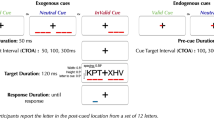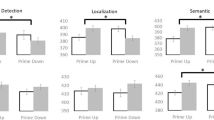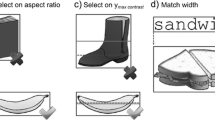Abstract
The association between a word and typical location (e.g., cloud—up) appears to modulate healthy individuals’ response times and visual attention. This study examined whether similar effects can be observed in a clinical population characterized by difficulties in both spatial representation and lexical processing. In an eye-tracking experiment, participants categorized spoken words as either up-associated or down-associated. Parkinson’s disease patients exhibited a tendency to maintain their visual attention in the upper half of the screen, however, this tendency was significantly lower when participants categorized concepts as down-associated. Instead, the control group showed no preference for either the upper or lower half of the screen. We argue that Parkinson’s disease patients present an over-reliance on space during word categorization as a form of cognitive compensation. Such compensation reveals that this clinical population may use spatial anchoring when categorizing words with a spatial association, even in the absence of explicit spatial cues.


Similar content being viewed by others
Notes
In “Appendix”, we present a regression model that directly compares experimental conditions, time windows and groups. The results point to the same conclusions.
References
Almeida, Q. J., & Lebold, C. A. (2010). Freezing of gait in Parkinsons’s disease: A perceptual cause for a motor impairment? Journal of Neurology, Neurosurgery and Psychiatry, 81, 513–518. https://doi.org/10.1136/jnnp.2008.160580.
Angwin, A. J., Chenery, H. J., Copland, D. A., Murdoch, B. E., & Silburn, P. A. (2006). Self-paced reading and sentence comprehension in Parkinson’s disease. Journal of Neurolinguistics, 19, 239–252. https://doi.org/10.1016/j.jneuroling.2005.11.004.
Barr, D. J., Levy, R., Scheepers, C., & Tily, H. J. (2013). Random effects structure for confirmatory hypothesis testing: Keep it maximal. Journal of Memory and Language, 68, 255–278. https://doi.org/10.1016/j.jml.2012.11.001.
Bates, D., Maechler, M., Bolker, B., & Walker, S. (2015). lme4: Linear mixed-effects models using Eigen and S4. R package v1. Journal of Statistical Software, 67, 1–7. https://doi.org/10.18637/jss.v067.i01.
Bergen, B. K., Lindsay, S., Matlock, T., & Narayanan, S. (2007). Spatial and linguistic aspects of visual imagery in sentence comprehension. Cognitive Science, 31, 733–764. https://doi.org/10.1080/03640210701530748.
Cardona, J. F., Gershanik, O. S., Gelormini-Lezama, C., Houck, A. L., Cardona, S., Kargieman, L., et al. (2013). Action-verb processing in Parkinson’s disease: New pathways for motor–language coupling. Brain Structure and Function, 218, 1355–1373. https://doi.org/10.1007/s00429-013-0510-1.
Clark, H. H. (1973). The language-as-fixed-effect fallacy: A critique of language statistics in psychological research. Journal of Verbal Learning and Verbal Behavior, 12, 335–359. https://doi.org/10.1016/S0022-5371(73)80014-3.
Collier, T. J., Kanaan, N. M., & Kordower, J. H. (2017). Aging and Parkinson’s disease: Different sides of the same coin? Movement Disorders, 32, 983–990. https://doi.org/10.1038/nrn3039.
Copland, D. (2003). The basal ganglia and semantic engagement: Potential insights from semantic priming in individuals with subcortical vascular lesions, Parkinson’s disease, and cortical lesions. Journal of the International Neuropsychological Society, 9, 1041–1052. https://doi.org/10.1017/S1355617703970081.
Dudschig, C., Souman, J., Lachmair, M., De la Vega, I., & Kaup, B. (2013). Reading “sun” and looking up: The influence of language on saccadic eye movements in the vertical dimension. PLoS ONE, 8, 2. https://doi.org/10.1371/journal.pone.0056872.
Fischer, B., & Ramsperger, E. (1984). Human express saccades: Extremely short reaction times of goal directed eye movements. Experimental Brain Research, 57, 191–195. https://doi.org/10.1007/BF00231145.
Friederici, A. D., Kotz, S. A., Werheid, K., Hein, G., & Von Cramon, D. (2003). Syntactic comprehension in Parkinson’s disease: Investigating early automatic and late integrational processes using event-related brain potentials. Journal of Neuropsychology, 17, 133–142. https://doi.org/10.1037/0894-4105.17.1.133.
García, A. M., Carrillo, F., Orozco-Arroyave, J. R., Trujillo, N., Vargas Bonilla, J. F., Fittipaldi, S., et al. (2016). How language flows when movements don’t: An automated analysis of spontaneous discourse in Parkinson’s disease. Brain and Language, 162, 19–28. https://doi.org/10.1016/j.bandl.2016.07.008.
Grossman, M., Cooke, A., DeVita, C., Lee, C., Alsop, D., Detre, J., et al. (2003). Grammatical and resource components of sentence processing in Parkinson’s disease: An fMRI study. Neurology, 60, 775–781. https://doi.org/10.1212/01.WNL.0000044398.73241.13.
Ibáñez, A., Cardona, J. F., Dos Santos, Y. V., Blenkmann, A., Aravena, P., Roca, M., et al. (2013). Motor-language coupling: Direct evidence from early Parkinson’s disease and intracranial cortical recordings. Cortex, 49, 968–984. https://doi.org/10.1016/j.cortex.2012.02.014.
Lachmair, M., Dudschig, C., DeFilippis, M., De la Vega, I., & Kaup, B. (2011). Root versus roof: Automatic activation of location information during word processing. Psychonomic Bulletin & Review, 18, 1180–1188. https://doi.org/10.1371/journal.pone.0056872.
Lee, A. C., & Harris, J. P. (1999). Problems with perception of space in Parkinson’s disease. Journal of Neuro-Ophthalmology, 22, 1–15. https://doi.org/10.1076/noph.22.1.1.3746.
Leung, I. H., Walton, C. C., Hallock, H., Lewis, S. J., Valenzuela, M., & Lampit, A. (2015). Cognitive training in Parkinson disease: A systematic review and meta-analysis. Neurology, 85, 1843–1851. https://doi.org/10.1212/WNL.0000000000002145.
Longworth, C. E., Keenan, S. E., Barker, R. A., Marslen-Wilson, W. D., & Tyler, L. K. (2005). The basal ganglia and rule-governed language use: Evidence from vascular and degenerative conditions. Brain, 128, 584–596. https://doi.org/10.1093/brain/awh387.
Monetta, L., & Pell, M. D. (2007). Effects of verbal working memory deficits on metaphor comprehension in patients with Parkinson’s disease. Brain and Language, 101(1), 80–89. https://doi.org/10.1016/j.bandl.2006.06.007.
Murray, L. L. (2008). Language and Parkinson’s disease. Annual Review of Applied Linguistics, 28, 113–127. https://doi.org/10.1017/S0267190508080100.
Ostarek, M., Ishag, A., Joosen, D., & Huettig, F. (2018). Saccade trajectories reveal dynamic interactions of semantic and spatial information during the processing of implicitly spatial words. Journal of Experimental Psychology. Learning, Memory, and Cognition, 44, 1658. https://doi.org/10.1037/xlm0000536.
Pecher, D., Van Dantzig, S., Boot, I., Zanolie, K., & Huber, D. (2010). Congruency between word position and meaning is caused by task-induced spatial attention. Frontiers in Psychology, 1, 30. https://doi.org/10.3389/fpsyg.2010.00030.
Peelle, J. E., Troiani, V., Wingfield, A., & Grossman, M. (2010). Neural processing during older adults’ comprehension of spoken sentences: Age differences in resource allocation and connectivity. Cerebral Cortex, 20, 773–782. https://doi.org/10.1093/cercor/bhp142.
R Core Team. (2020). R: A language and environment for statistical computing. Vienna, Austria: R Foundation for Statistical Computing. https://www.R-project.org/.
Richardson, D. C., & Kirkham, N. Z. (2004). Multimodal events and moving locations: Eye movements of adults and 6-month-olds reveal dynamic spatial indexing. Journal of Experimental Psychology: General, 133, 46–62. https://doi.org/10.1037/0096-3445.133.1.46.
Richardson, D. C., Spivey, M. J., Edelman, S., & Naples, A. D. (2001). “Language is spatial”: Experimental evidence for image schemas of concrete and abstract verbs. In J. D. Moore & K. Stenning (Eds.), Proceedings of the 23rd annual meeting of the cognitive science society (pp. 873–878). Lawrence Erlbaum.
Spivey, M. J., & Geng, J. J. (2001). Oculomotor mechanisms activated by imagery and memory: Eye movements to absent objects. Psychological Research, 65(4), 235–241. https://doi.org/10.1007/s004260100059.
Stine-Morrow, E. A., Miller, L. M., & Hertzog, C. (2006). Aging and self-regulated language processing. Psychological Bulletin, 132, 582–606. https://doi.org/10.1037/0033-2909.132.4.582.
Troster, A. I. (2011). A precis of recent advances in the neuro- psychology of mild cognitive impairment(s) in Parkinson’s disease and a proposal of preliminary research criteria. Journal of the International Neuropsychological Society, 17, 393–406. https://doi.org/10.1017/S1355617711000257.
Venables, W. N., & Ripley, B. D. (2002). Tree-based methods. Modern Applied Statistics with S. Springer. https://doi.org/10.1007/978-1-4757-3121-7_10.
Wingfield, A., Aberdeen, J. S., & Stine-Morrow, E. A. (1991). Word onset gating and linguistic context in spoken word recognition by young and elderly adults. The Journals of Gerontology, 46, 127–129. https://doi.org/10.1093/geronj/46.3.P127.
Wingfield, A., & Grossman, M. (2006). Language and the aging brain: patterns of neural compensation revealed by functional brain imaging. Journal of Neurophysiology, 96, 2830–2839. https://doi.org/10.1152/jn.00628.2006.
Wong, O. W. H., Chan, A. Y. Y., Wong, A., Lau, C. K. Y., Yeung, J. H. M., Mok, V. C. T., et al. (2018). Eye movement parameters and cognitive functions in Parkinson’s disease patients without dementia. Parkinsonism and Related Disorders, 52, 43–48. https://doi.org/10.1016/j.parkreldis.2018.03.013.
Acknowledgements
This work was supported by the Agencia Nacional de Investigación y Desarrollo (ANID; National Agency for Research and Development, Government of Chile) under grant FONDECYT N°1150336 “Representaciones espaciales en la comprensión del lenguaje en pacientes con enfermedad de Parkinson” to BR. Support from ANID/PIA/Basal Funds for Centers of Excellence FB0003 to EG is also gratefully acknowledged.
Author information
Authors and Affiliations
Corresponding author
Ethics declarations
Conflicts of interest
The authors declare that the research was conducted in the absence of any scientific, commercial or financial relationships that could be construed as a potential conflict of interest.
Ethical Approval
All procedures performed in studies involving human participants were in accordance with the ethical standards of the institutional and national research committee and with the Helsinki declaration and its later amendments or comparable ethical standards.
Informed Consent
Informed consent was obtained from all individual participants included in the study.
Additional information
Publisher's Note
Springer Nature remains neutral with regard to jurisdictional claims in published maps and institutional affiliations.
Appendix
Appendix
We present the results from a GLMM analysis that directly contrast the experimental groups. We followed a model comparison approach given the highly complex random structure this analysis demands if all random factors justified by the design are included. We compared four models of increasingly complex random structure: (1) a random intercept model only, (2) a main effect random slopes model, (3) a model with all two-way interactions as random slopes, and (4) a model with all three-way interactions as random slopes. Model comparison revealed that the most parsimonious model was that with main effects as random slopes. All our data and code are available at https://osf.io/gyqmf/.
β | se | z | p | |
|---|---|---|---|---|
(Intercept) | − 5.210 | 0.844 | − 6.17 | 0.000*** |
Word | − 0.097 | 0.065 | − 1.50 | 0.135 |
Region | 0.590 | 0.196 | 3.01 | 0.003** |
Time window contrast | − 0.237 | 0.101 | − 2.35 | 0.019* |
Group | 0.409 | 0.844 | 0.48 | 0.628 |
Word * region | 0.182 | 0.041 | 4.47 | 0.000*** |
Word * time window contrast | − 0.059 | 0.078 | − 0.75 | 0.451 |
Word * group | 0.153 | 0.065 | 2.35 | 0.019* |
Region * time window contrast | 0.012 | 0.078 | 0.16 | 0.877 |
Region * group | − 0.391 | 0.196 | − 2.00 | 0.045** |
Time window contrast * Group | − 0.011 | 0.101 | − 0.11 | 0.915 |
Word * region * time window contrast | 0.102 | 0.078 | 1.31 | 0.192 |
Word * region * group | − 0.096 | 0.041 | − 2.36 | 0.018* |
Word * time window contrast * group | 0.081 | 0.078 | 1.03 | 0.304 |
Region * time window contrast * group | − 0.027 | 0.078 | − 0.35 | 0.728 |
Word * region * time window contrast * group | − 0.035 | 0.078 | − 0.45 | 0.652 |
Rights and permissions
About this article
Cite this article
Riffo, B., Guerra, E., Rojas, C. et al. Strategic Spatial Anchoring as Cognitive Compensation During Word Categorization in Parkinson’s Disease: Evidence from Eye Movements. J Psycholinguist Res 49, 823–836 (2020). https://doi.org/10.1007/s10936-020-09718-3
Published:
Issue Date:
DOI: https://doi.org/10.1007/s10936-020-09718-3




